Tracing the journey of microplastics in the Arctic
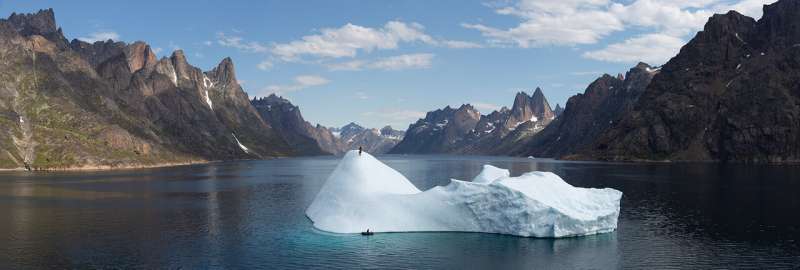
By now it's well established that microplastics are a problem in the environment, even in the remotest parts of the planet. But where do different microplastics come from and how they get there, especially in the Arctic?
When two of Jacob Berg Lofthus's friends invited him to sail to Greenland this summer, his first thought was, "Yes!".
His second thought was, "Can I do some science during the trip?"
So he went to see his supervisor, Chantel Nixon, an NTNU geologist who specializes in physical geography and ice age geology. Berg Lofthus is one of Nixon's master's students, but is studying avalanches.
"When I decided to go on the trip, I wanted to do something else as well, because I love geology and geography," Berg Lofthus said. "So I knocked on her door and asked if I could do some interesting research in Greenland, and she said yes."
Nixon, as it happens, had just launched a research program on microplastics in coastal marine sediments called COMPAS (COastal MicroPlastics—into Arctic Sediment) but with a focus on Svalbard and mainland Norway. Nixon and her graduate students are mapping microplastic sources, transport pathways and sinks in Arctic coastal environments.
So she applied for—and got—permits from the Greenland government to take sediment and driftwood samples from different Greenland beaches.
"This was a reconnaissance trip," Nixon said. "But it fits perfectly into my plastics and coastal sediments program. What I want to know is, are microplastics in Arctic coastal sediments coming from sea ice and ocean currents, or from communities?"
Then she sent Berg Lofthus off on a two-an-a half-month cruise with a roll of aluminum foil, a teaspoon, and instructions on how to take the samples to avoid contaminating them with plastic.
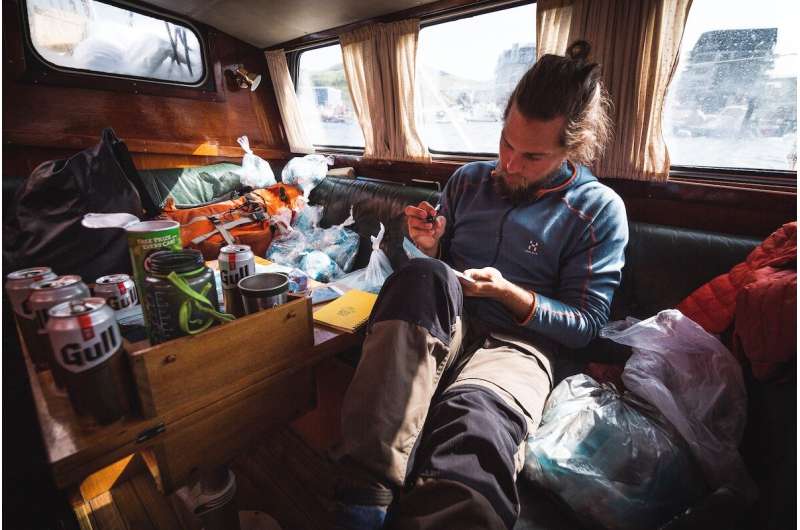
Microplastics everywhere
Researchers estimate that roughly 8 million tons of plastic move from the land to the sea every year, yet only one percent of this plastic has actually been accounted for.
All plastic in the ocean is a problem—think of the photos of dead albatrosses with bellies full of plastic, or sea turtles snagged by plastic bags. So in some ways, it might seem like a good thing that plastic breaks down over time.
But as the forces of sunlight, wind and waves degrade plastic and break it into ever smaller pieces, it becomes a problem of a whole different magnitude.
When plastic reaches a size of less than 5 millimeters, it's called microplastic—and the range of marine creatures that can ingest the stuff expands astronomically.
Just as with other pollutants that can be biomagnified, if small creatures eat microplastic—which they do—then the creatures that eat them will concentrate the plastics in their bodies. And then when these creatures are eaten by other, larger creatures up the food chain, the microplastics are also eaten and concentrated in the larger predators. Until, of course, you or I eat these larger predators, and then the microplastics end up inside of us, too.
From driftwood to microplastics
Nixon has a history of figuring out how things move around in the Arctic—one of her research projects involved reconstructing an 11,000-year-old history of driftwood delivery to an Arctic island in Canada.
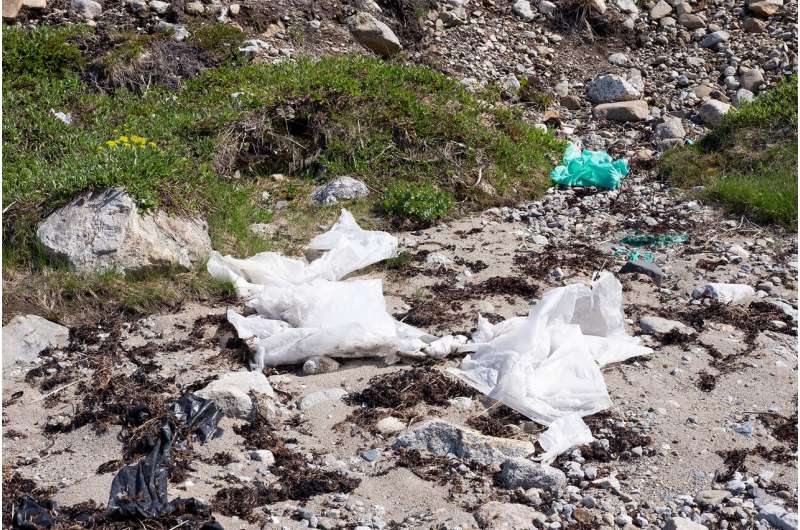
But the thing about driftwood in the Arctic Ocean, she says, is that it really can't travel very far unless it is carried by sea ice. Without being borne by ice, the wood gets waterlogged and sinks to the bottom in approximately 2 years.
Sea ice and surface water move around the Arctic Ocean for more than 2 years due to two big currents—the Beaufort Gyre and the Trans Polar Drift, she said. This means that sea ice and surface water, and also anything floating in it or stuck in the sea ice are stuck in the Arctic Ocean before exiting to the North Atlantic.
Tree type gives clues as to its source
Nixon and other researchers can also figure out where the driftwood comes from because they can identify the type of tree the driftwood was, by looking at cell structures in the wood.
"In general, the driftwood that flows down the big rivers that gets frozen into sea ice comes from either the Mackenzie River in Canada or the big Siberian rivers in Russia," she said. "Siberia is dominated by spruce and larch, while the boreal forests of North America are dominated by spruce. So if the driftwood is larch, it's probably from Siberia, if it's spruce it's from Canada."
At its fundament, however, mapping and analyzing the movement of driftwood in the Arctic is a way to know just how sea ice moves in the Arctic.
Knowing how sea ice moves is also a way to figure out how microplastics in the Arctic move, because sea ice contains microplastic.
Sometimes lots of it.
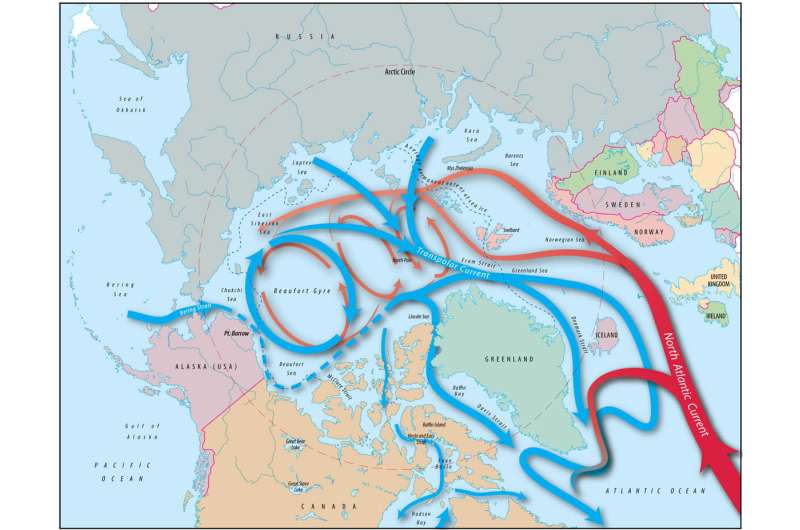
Rough coasts, stormy seas and growlers
You might think that taking sediment samples from Greenland beaches wouldn't be that hard. But between winds, waves and icebergs, it was anything but, Berg Lofthus said.
"It was a real challenge to find places to take sediment samples, because the east coast is so exposed," he said. And the other trick is just finding beaches to begin with.
"I was looking for sandy beaches with nothing bigger than coarse sand, because bigger is higher energy and the microplastics wouldn't get trapped there," he said. "I was looking at Google Maps all the time, trying to find small, light colored areas that could be beaches."
There was more, of course. They saw whales every day, and one night they actually accidentally grazed a whale with the sailboat. If there were lots of icebergs, the crew of six had to share iceberg watch.
"The most dangerous are the growlers," he said. "They are smaller than icebergs but can really do some damage."
Fieldwork in a remote place—but with a small carbon footprint
In the end, Berg Lofthus was able to collect from 10 beaches on the east, west and south coasts during the sailboat's journey from Tasilaq on the east coast to Nuuk on the west coast and back. He also collected driftwood from the same beaches, all of which will be analyzed by Nixon and her graduate students.
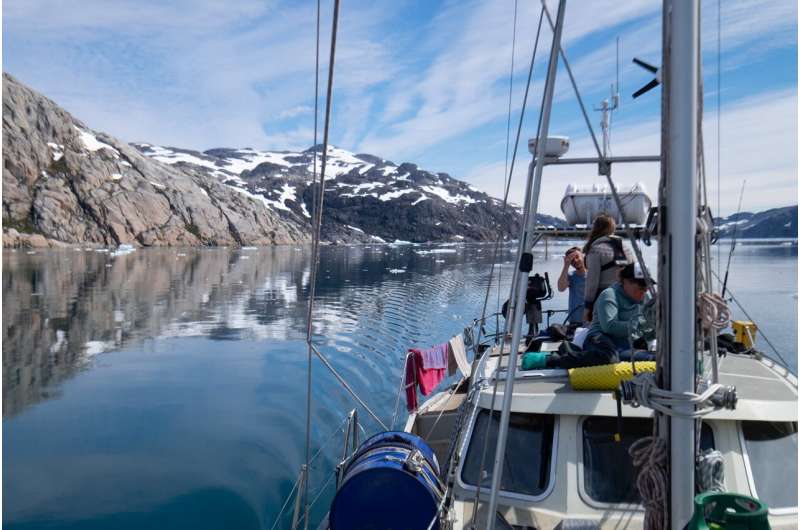
Nixon said she was very thankful that both Berg Lofthus and his sailing friends, who own Ægir Expeditions and the boat that sailed to Greenland, were both open and enthusiastic to helping with the microplastics research. As a result, Nixon has been able to expand COMPAS, her new research program, to Greenland.
Another advantage was that Berg Lofthus was able to collect samples without the use of a giant research vessel, or for that matter, even a plane, which really reduced the carbon footprint of the fieldwork.
"I think it is very important that researchers who do fieldwork start doing a lot more of this type of thing to reduce our carbon footprints," Nixon said. "I hope to work with them again if possible and explore other ways to acquire data for research that doesn't involve flying."
Learning the fate of microplastics
Nixon says there are enormous gaps in what researchers know about marine microplastics at the global scale, especially in polar regions. She hopes the COMPAS program can help fill some of those knowledge gaps.
"The ultimate fate of microplastics frozen into sea ice is a large unknown, although much of it must certainly be released into Arctic coastal environments and the North Atlantic," she said. "This knowledge is essential for coastal communities and governments to monitor, mitigate and manage plastic pollution."
Provided by Norwegian University of Science and Technology




















